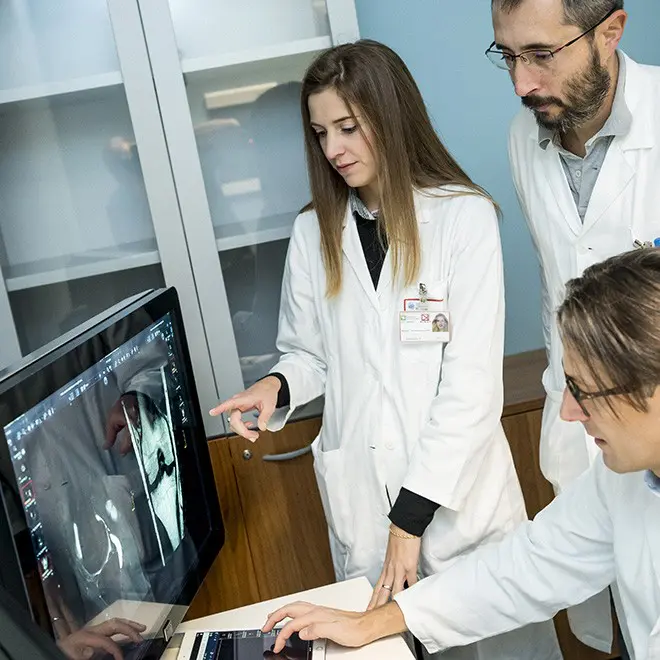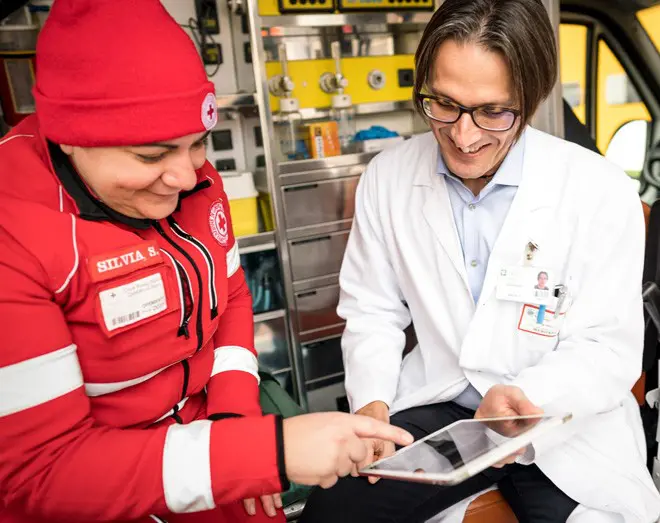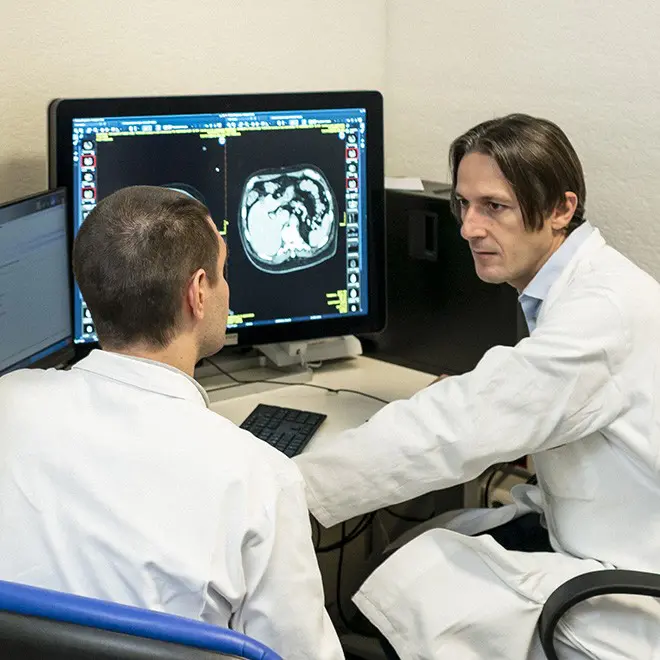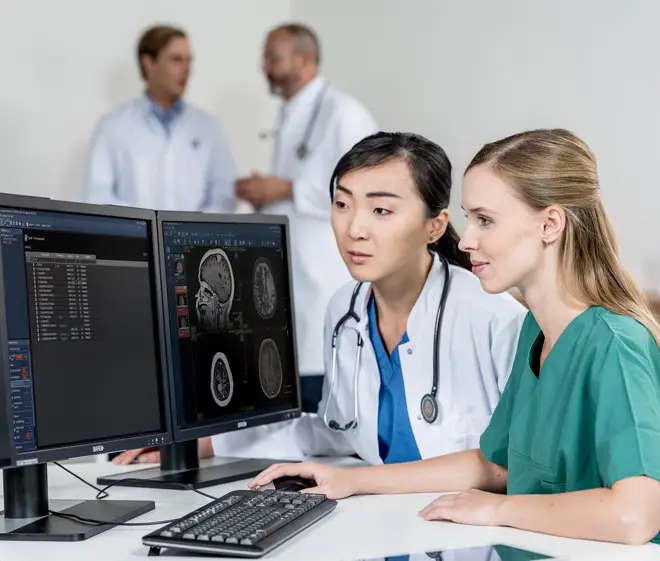
Dr. Davide Ippolito,
Head of the Emergency Radiology Unit
“Everything is simpler and faster, yet there are new functionalities for the evolving challenges we face.
Enterprise Imaging answers our need for performance, flexibility, speed, ease of use and collaboration.”
Transitioning to Enterprise Imaging has given the busy emergency radiology unit of San Gerardo Hospital, Italy, the productivity and flexibility to keep up with its increased image volume
The universally growing demand for diagnostic imaging is putting strain on radiology environments, including those in emergency departments. More images provide more diagnostic insight, but can also overwhelm an already busy care environment.
For San Gerardo Hospital, in Monza, Italy, the addition of new CT and MRI scanners over the past few years marked a turning point in the approach to image handling. “With this new equipment, we had a lot more images to look at. We needed an image management system offering both high performance and flexibility,” explains Dr. Davide Ippolito, head of the emergency radiology unit. “At the same time, we wanted a solution that would support us in our mission to provide other departments throughout the hospital with the maximum amount of information, as quickly as possible.”
A growing demand with new requirements
With these requirements in mind, this long-term Agfa HealthCare customer made the decision in 2018 to move to Enterprise Imaging. “We were fine with our Agfa HealthCare legacy PACS, but Enterprise Imaging has added important new functions that help us to meet our challenges in terms of productivity, collaboration, mobility and more,” says Dr. Ippolito.

A strong focus on oncology
San Gerardo Hospital is a 1000-bed hospital with three separate, but connected, radiology areas; Dr. Ippolito is responsible for the emergency radiology unit. He is also a professor at the University of Milano-Bicocca, Department of Surgery and Interdisciplinary Medicine, which is linked with the hospital.
Radiology in the emergency department sees patients with, for example, high-impact traumas, but it also handles patients with longer-term pathologies, who come to the emergency room (ER) while experiencing various symptoms. “Our hospital has a strong focus on oncology, so we often get patients who have already had many imaging exams done, and whose care will go beyond their ER visit. When they come to the emergency department, we may need to determine, for example, if their symptoms are caused by pneumonia or by lung tumor, if lesions have evolved, etc.,” explains Dr. Ippolito.
In our radiology department, we mainly focus on oncology and emergency imaging.
This creates some specific needs, which Enterprise Imaging fills:

Hanging protocols
Combining speed and customized viewing
At San Gerardo Hospital, Enterprise Imaging is reducing the time the radiologist needs to look at or reanalyze exams. “Everything is simpler and faster. We can look at more exams, and quickly retrieve priors.
Then there are the hanging protocols, which are useful to evaluate the images – whether from CT, X-ray or MRI – in the radiologist’s preferred way, customizing the windowing view,” says Dr. Ippolito.
One of the hanging protocols enables the sagittal, coronal and axial planes to be viewed promptly, while another lets the radiologist compare exams from newest to oldest. “This last one helps us to quickly identify a lesion and then measure it, speeding up time to diagnosis and, as we know, timely diagnosis is important for timely treatment, of course.”
“With Enterprise Imaging, we can now produce 80% of our reports within 24 hours. For inpatients, this is often done in less than 12 hours – i.e. same day/shift turnaround.”
Simpler working life of both radiologist and physician
Enterprise Imaging also extends the collaboration of the radiologists with their physician peers in other departments.
“With Enterprise Imaging, we can make a snapshot that focuses on the lesion or key area we want the physician to take a look at, and when the physician opens the patient’s folder, he can view this snapshot and concentrate on the area of interest.
Moreover with the XERO Universal Viewer, physicians can make volume-viewing, annotation and image modification, etc., from their personal computer.
“These functions simplify the working life of both radiologist and physicians.”

Remote reading
Provided by Enterprise Imaging’s remote diagnostic desktop
The mobility offered by Enterprise Imaging’s remote diagnostic desktop is especially important to Dr. Ippolito: “I enjoy the remote reading! This was one of the most important criteria for me in choosing Enterprise Imaging.”
“As both head of a unit and as university professor, I frequently work with a lot of residents and younger colleagues; it is very important to me to have a system that allows me to work from home and check exams, or support my colleagues in remote mode. Also, when I travel abroad and meet peers, I can show them what we are doing, and the many opportunities that the mobility of Enterprise Imaging can create are really exciting.”

Radiology as a learning environment
As a university-linked hospital, San Gerardo works with residents with varying degrees of experience.
The Enterprise Imaging workflows support radiology as a learning environment, while supporting a high level of patient care.
“First of all, in the ER, we know that for our younger colleagues, certain X-rays or CT scans can be very challenging. With Enterprise Imaging, it is possible to share studies, in both directions. Residents can ask a mentor for feedback or assistance, or a senior radiologist can check the residents’ work. And they can look at the images together, both for emergency and non-emergency cases, to discuss and improve skills directly.”
“The teaching workflows also support residents to make diagnoses,” Dr. Ippolito continues. “We can save the most interesting cases, highlighting the specific disease. When a resident comes across a suspected presentation of, say, a meniscal lesion, he can go to the teaching file and compare the images to what is in front of him. In this way, he can be more confident in his diagnosis, while also learning.”
This function is also useful when a radiologist – regardless of experience – is faced with a rare disease, he adds. “We can quickly compare what we are seeing with older exams, plus we can check both the pathology results and clinical exams. Finally, this function is very useful if we want to check how many cases of a specific rare disease we get in a year.”

Looking in the right place the first time
“One key way in which Enterprise Imaging makes a real difference in our emergency radiology unit is how it helps us to focus on the actual health issues we need to address, so we – and the physicians – don’t waste time looking in the wrong place. Many of the functions contribute: retrieving other images, viewing everything in one window, taking and sharing screenshots of the region of interest, chatting in real time … Everything is simpler and faster, yet there are new functionalities for the evolving challenges we face.”
“Enterprise Imaging answers our need for performance, flexibility, speed, ease of use and collaboration. And I do enjoy the remote reading,” Dr. Ippolito concludes.
Agfa HealthCare’s solution & contribution
Solution
- The single, unified imaging platform, which is used at San Gerardo’s three radiology departments, offers intuitive use and a powerful workflow engine.
- Hanging protocols save time for radiologists by creating a consistent study presentation while remaining flexible.
- Native and embedded clinical applications make the radiologist’s work smoother and faster.
- Images and studies can be flagged, anonymized, tagged with the relevant clinical details, and saved as teaching files.
- Chat and sharing functions keep residents and attending physicians connected, in real-time and visually. Radiologists can also use the functions for second opinions, etc.
- With the remote reading, radiologists can access images and create reports when away from the hospital.
- Physicians throughout the hospital can view radiology images on their own computers, and access visualization and measurement tools.
- Radiologists can review results with their colleagues in other departments, improving patient care and highlighting the value of the radiologist’s insight.
Contribution
- Agfa HealthCare’s team worked 24 hours a day during the implementation.
- The Agfa HealthCare support team spent a week at the hospital to help the doctors solve any problems.
- Training was divided into two parts. The first took a week, and covered the more basic features: viewing, reporting, checking images reconstructed with MPR, etc. A second training session dealt with the more complex functionality and some specific issues that had arisen.





